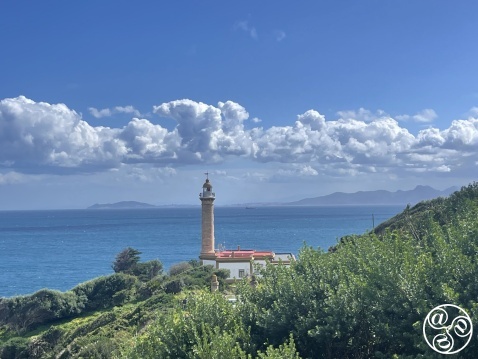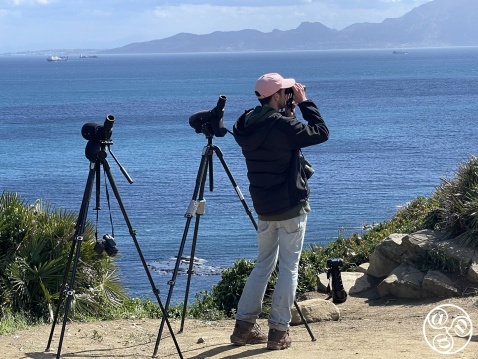
Punto Carnero and the Lighthouse on the headland west of Getares the district of Algeciras © Michelle Chaplow |
|
Punto Carnero Lighthouse, Algeciras
A guide to Punto Carnero and the Lighthouse on the headland west of Getares the district of Algeciras
Punto Carnero and the Lighthouse: A Hidden Gem Near Getares, Algeciras
Nestled on the headland west of Getares, in the southern district of Algeciras, Punto Carnero and its historic lighthouse offer visitors a breathtaking experience of the Strait of Gibraltar. This scenic spot is one of the most remarkable coastal viewpoints in the region, boasting unparalleled panoramas of the iconic Rock of Gibraltar and the distant mountains of North Africa. Whether you are drawn by the dramatic landscapes, the historical significance of the lighthouse, or the serenity of nature, Punto Carnero is a must-visit destination.
The Lighthouse and Coastal Beauty
The Punto Carnero Lighthouse, first lit in 1874, is a striking feature of this rugged coastline. Built to guide ships safely through the busy waters of the Strait of Gibraltar, the lighthouse still stands as a sentinel over the waves, casting its beam across one of the world’s most important maritime routes. Its classic cylindrical stone tower, painted white, provides a picturesque contrast against the deep blue of the sea and sky. This area offers a tranquil retreat from the bustle of Algeciras, where visitors can appreciate the sound of the waves, the salty sea breeze, and the mesmerising play of light on the water.
The views from this headland are truly spectacular. On clear days, the Rock of Gibraltar dominates the horizon to the east, an unmistakable natural fortress rising from the sea. To the south, the coastline of Morocco stretches into the distance, its rugged cliffs and mountains forming a dramatic backdrop. As the sun sets, the sky transforms into a stunning palette of oranges and pinks, making this an ideal spot for photography.
History of Punta Carnero Lighthouse
The need for a lighthouse was included in the "General Plan for the Maritime Lighting of the Coasts and Ports of Spain and the Islands" of 1858, with the idea of signalling the entrance to the Bay of Algeciras, marking the Bajo de La Perla. The definitive project for the Punta Carnero lighthouse was finally drawn up in 1864 by the civil engineer Jaime Font y Escolá, with an optical system of the 5th order and a fixed red light.
Although its construction was authorised by royal decree on 30th November 1864, the Lighthouse Commission seriously considered stopping the lighthouse project to avoid confusion with the lighthouse of Tarifa on the Isla de las Palomas, which had to switch to red light after the inauguration of the new lighthouse of Cabo Espartel on the north coast of Morocco four years earlier.
Following requests from the English 'Trinity House' and others, the Lighthouse Commission decided to continue with the construction of the Punta Carnero lighthouse, but with a fixed green light instead of the red one originally planned. The lighthouse was inaugurated in 1874 next to the old fort of Punta Carnero, which had been destroyed in 1810.
The lighthouse has a cylindrical tower made of sandstone, with a similar style shaft, but on a smaller scale, with the lighthouses of Chipiona and San Jerónimo, designed by the same engineer. The upper body rests on a cornice with a metal railing supported by corbels, on which the lantern rests, whose focal point is 42 metres above sea level and 19 metres above the ground.
In 1908, the lantern had a fixed green light produced by a single-wick maris lamp, which had replaced the primitive rapeseed oil lamp. In the same year, it was modified by changing its light to white, with groups of three beams alternating with a single beam. To mark the lower part of La Perla, the lantern has a red sector.
In 1973 the lighthouse was electrified with the current mixed gas and electricity system, and two years later a new siren was installed. In 1997 the light was renewed and the lighthouse was automated. It was the last lighthouse to be managed by the Algeciras Port Authority, where a lighthouse keeper lived until 2018. It is located in the Parque Natural de la Estrecho
Punto Carnero is a Birdwatching Paradise
For nature lovers and birdwatchers, Punto Carnero is a haven of avian activity. Situated within the Parque Natural del Estrecho (The Strait Natural Park), this region is an essential stop for migratory birds traveling between Europe and Africa. The headland provides an excellent vantage point to witness the seasonal movements of thousands of birds, including raptors such as eagles, kestrels, and falcons, as well as storks and a variety of seabirds. Birdwatchers can bring their binoculars and cameras to just marvel at the sight of these magnificent creatures soaring across the strait, often taking advantage of the strong winds to glide effortlessly above the waves. Spring and autumn are particularly rewarding times to visit, as these seasons mark the peak of migration. One popular bird watching locations are at the lighthouse parking on its the spur road where turning round is difficult but possible. Another popular location is at the view-point Mirador de Punta Carneo with careful roadside parking.
A Natural Park of Outstanding Beauty
Punto Carnero is part of Parque Natural del Estrecho, a protected area that encompasses some of the most ecologically significant landscapes in southern Spain. The park is known for its rich biodiversity, with coastal cliffs, marine ecosystems, and Mediterranean vegetation creating a unique environment for flora and fauna. Hiking trails in the area offer stunning coastal walks, where visitors can explore unspoiled beaches, rocky outcrops, and verdant hillsides. The park’s conservation efforts ensure that its natural beauty remains unspoiled, making it an ideal location for eco-tourism and outdoor adventures.
Whether you are an avid nature enthusiast, a history buff, or simply in search of a scenic escape, Punto Carnero and its lighthouse promise an unforgettable experience. This hidden gem, with its dramatic views, rich wildlife, and peaceful ambiance, is a place where land and sea converge in perfect harmony, offering a true taste of Andalusia’s coastal charm.
Discover the coves of Getares
At the edge of the village the road stops and a track begins, so park the car and walk. The first cove is called Cala Fuerte with its small island called Isla de las Palomas, the second is called Cala del Peral. After Punta de la Tia Abelica is a third small unnamed cove, after Punta Chorilito is the largest and best sandy beach Cala Arenas.
Restaurants
A little way past the lighthouse viewpoint lies Zona Punta Carnero, a small, secluded coastal district. Here, you'll find Puro Estrecho, an excellent restaurant that opened on April 17, 2015, offering a memorable dining experience with sea views and a swimming pool.
Ruta Paco de Lucia
The song 'Punta del Faro' (Lighthouse Point) (Listen on YouTube) is the name of a bulerías-style flamenco composition from his 1972 album 'El duende flamenco', the year in which José Monge Cruz, better known as 'Camarón de la Isla', worked together in Algeciras. Camarón and Paco recorded their first album in 1969 under the direction of Paco's father. It was then that the two of them, singer and guitarist, began their revolution in orthodox flamenco.
Driving from Algeciras to Punta Carnero, you can get an idea of how the power of the landscape could have influenced Paco's work. You pass the Getares inlet, an old whaling station, and cross the creeks that flow into the bay to reach the lighthouse, from where you can see the Moroccan coast at its best. To the west, the Atlantic, cold and dangerous, on the way to the New World. To the east, the warm Mediterranean, Greek and Roman.
This is what the guitarist was referring to when, in 1973, he composed Entre dos Aguas, an improvised song that went on to become the number one song in Spain and brought him international recognition and a performance at the Teatro Real in Madrid in 1975. More about Ruta de Paco de Lucia
More about Algeciras beaches
More about Algeciras
More about Ruta de Paco de Lucia
How to get there
To the west of Algeciras, four small coves with pristine beaches can be reached only on foot. Traveling along the CA-233 from Algeciras, past Getares, you’ll come across these hidden gems, including Cala de la Cañonera and Cala de la Mozilla, before arriving at the lighthouse on Punta Carnero.
This coastal stretch features fascinating rock formations and a distinctive line of rocks known as Isla Cabrita. Continuing further, you'll reach Mirador Punta Carnero, a popular viewpoint for birdwatchers offering stunning views over Cala de la Para. Unfortunately, there is no official parking to accommodate visitors.



